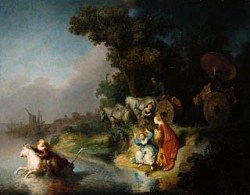 |
||
Works of art often tell stories. Narrative art refers to the works of art that tell these stories. The image the artist creates may relate a myth, a religious story, a story from history, or a well-known fable or tale. Artists tell the story by including character(s), setting, and plot—similar devices as those used by writers. The lessons in this curriculum explore the various forms of narrative art, including monoscenic narrative, continuous narrative, and sequential narrative.
The materials in the lessons are designed for elementary and secondary teachers to prompt discussion and activities related to narrative art in the J. Paul Getty Museum collection. Seven objects from the collection were chosen to represent the different forms of narrative art. The objects were also chosen for their potential uses as teaching tools. Questions and activities in the lessons are offered as suggestions, and should be adapted to fit the needs of different grade levels and particular classrooms.
A "Background Information and Questions for Teaching" sheet for each object is provided in each lesson and in the Image Bank. Scan the "Background Information" before using the "Questions for Teaching" to direct student observations of artworks. All activities connect to visual arts and language arts content areas for elementary and secondary students in the State of California.